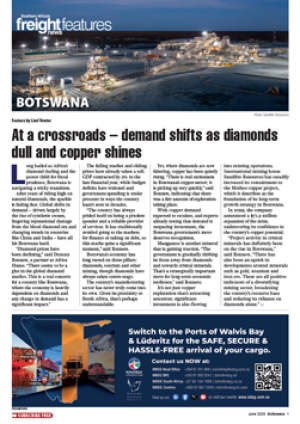South Africa has lost and
will continue to lose
trillions of rand in earnings
as the country turns a blind
eye to the potential lurking
in the ships’ bunker fuel
industry, according to Haydn
Lockhart-Barker, chairman
of the International Bunker
Industry Association (IBIA),
Southern African branch.
SA ports' “exorbitant”
berthing fees, and no
berthing priority, means the
bunker-hungry ships out
there sail on to other more
economically priced and
customer-friendly fuelling
points.
Quoting a report done in
2006 by Professor Trevor
Jones, head of maritime
studies at the University of
Kwa Zulu Natal, Lockhart-
Barker added: “Some say
that Durban is amongst the
10 most expensive ports in
the world. But we say, from a
bunkering point of view, it is
THE most expensive.
“Excluding fuel oil
expenditure, these ships
release between R2-R4m a
day in commercial activity
– in crew as well as ship
logistics-related expenses.
Hotel, airline, taxi and ship
repair industries could be
amongst the recipients.”
Now, the removal of
pipeline facilities in the
Port of Durban – as well
as only prioritising the
container vessel market,
with the resultant lack
of berth availability for
“bunkers only” vessels – have
exacerbated an already
precarious situation. And
the ship operators rely on
a quick turnaround time
as ship operations are very
costly, he added.
Another problem is the
composition of ships’ bunker
fuel currently available in
SA. “Generally speaking
most ships burn a 380cst
(centistoke) because it’s
cheaper,” he said. “But, due
to various reasons, the fuel
we produce, although of a
higher quality, is a 180cst,
and is therefore priced
higher.”
And pricing is an issue.
The traditional “bunkers
only” market mainly
comprises dry cargo
operators plying the trades
between South America
and Asia, according to
Lockhart-Barker, with SA
perfectly and strategically
positioned almost right in
the middle.
“But Argentina has
developed a liberalised
market economy on the
supply of bunker fuel, and
has developed a safe offshore
bunkering facility in
an area referred to as the
Common Zone,”
Lockhart-Barker said.
And “on-the-day pricing”
when this interview took
place, showed that the
Buenos Aires pricing of
LS 380cst was US$595 per
metric tonne “delivered”.
This meant an all-inclusive
price, plus a small agency
handling fee compared
to Durban’s US$626/mt
for high-sulphur – plus
US$11.10 for barging.
“Add to that upwards of
US$20 000 port calling
costs and it makes SA
a wholly uncompetitive
market,” he added.
“So, if you talk about
developing the SA
market, the fact that the
ownership of the bunker
fuel infrastructure in these
ports is unable to store
imported product or
deliver the fuel the market
requires is a major
stopper.”
But, according to
the IBIA, there is an
opportunity to awaken
this now slumbering
SA bunkering industry.
Since 1997 the bunkering
turnover per year has
been halved from 2.2
million tonnes to 1.1m
tonnes. That’s over 900
ships a year lost to the
SA market.
“In 2013, a Handysize
vessel coming in for
bunkers at the Port of
Durban would incur
port costs in excess of
US$15 000 per day,
compared to US$1 200
per day in 2000,”
Lockhart-Barker said.
“Now, these vessels also
receive the lowest priority
by the port authorities.
Add the cost of fuel and the
barging, then you arrive
at a point where it doesn’t
make any economic sense
for ships to refuel at any of
our ports.
“In essence, the shipping
market changed, but the
SA players just couldn’t read
it.”
Realistically, the market
now demands an additional
“outside port limits” (OPL),
offshore bunkering facility,
he insisted. The success of
the West African offshore
refuelling market and many
others
bears
testimony
to the
fact that
safe and
efficient
shipto-
ship
transfer
worldwide
is the
correct
model to
follow.
This is
something
IBIA
supports, as it has been
involved in setting up
similar “best practice”
operations in the ports of
Singapore and Gibraltar
for precisely this reason.
They believe that, by
setting up legislated bunker
procedures, in combination
with all private and public
stakeholders, cooperation
is the way forward. There
are already a few local
options to consider.
“We believe the country
as a whole would benefit if
the market was opened up
in a thoughtful and
regulated manner, especially
with regard to capitalisation
of the previous
disadvantaged
groupings,
which are
hugely underrepresented
in
this sector.
SA is crying
out for input
for joint
ventures
between local
and foreign
operators,”
said Lockhart-
Barker.
The IBIA
also wants
the government to have a
strong look at doing offshore
bunkering. As an example,
Gibraltar, which also has
a regular passing trade as
ships sail in and out of the
Med, sells 4.9 million tonnes
a year – from selling nothing
ten years ago.
INSERT & CAPTION
From a bunkering
point of view, we
believe Durban
Port is THE most
expensive in the
world.
– Hayd0n Lockhart-Barker

